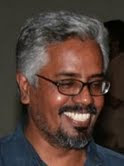Televised Kathakali
Kathakali - From Television to Video and Beyond
The establishment of Kalamandalam way back in 1930, at the initiative of the legendary Vallathol and Mukunda Raja, was instrumental in preserving art forms like Kathakali and Koodiyattam and bringing it out from the claustrophobic spaces of the temples and elite households. Kalamandalam played a great role in secularizing and popularizing the art, taking it around the world and the country.
In the last decades, the emergence of Television has done something similar to such art forms, especially Kathakali. Television in fact revolutionized the very act and manner of viewing and enjoying the art, as well as preserving it for future generations and patronizing it now. The first to recognize such potential was Asianet who after covering a number of Kathakali-related events like the saptati of Kalamandalam Ramankutty Nair, went on to organize the Kathakali Samaroh (produced by M R Rajan, whose contribution to 'filming of performing arts' in Kerala is yet to be properly recognised) for three consecutive years (2000-02). These Samarohs not only showcased the performance of almost all the major kathakali artists, but for the first time created a slot for kathakali in television. Those hundreds of hours of performance preserve the state of kathakali at the turn of the century for generations to come. Another innovative turn towards popularizing the art was subtitling, which broke the barriers of the art's supposed-to-be-obscure language of angika-abhinaya and mudras. It is a pity that Asianet withdrew from the project. Ironically, the footages of the Samaroh are still being telecast through its News Channel to the delight of Kathakali lovers worldwide, and even finding a place in TAM ratings! Kairali TV took up the Samaroh for one year before backing out, and now Amrita TV has taken a similar initiative. Our channels are yet to realize the archival value of such recordings, apart from its sheer economic sense, that of creating sufficient and interesting software that is amenable to repeated viewing unlike almost all the other TV programmes. In other words, it is just like buying the exhibition rights of films.
On the other side, the televising of kathakali also had its impact on the practice of the art. Apart from preservation, it also made it possible for the first time for the kathakali artists themselves to watch their performance, which was impossible earlier (This point was brought to my attention by K C Narayanan) This facility to view one's own performance, helped a great deal in improving and improvising the same later. Though many films have been made on legendary Kathakali maestros, they could have never imagined the reach that television gave it.
The popularity created by television and the creation of a niche market, is evident from several contemporary initiatives in the visual media. For instance the Vazhenkade Kunchu Nair Trust which was also instrumental in organizing the Samaroh, has brought out a series of VCDs 'Masters' Masterpieces' – of Banayuddham, Utthara Swayamvaram and Thoranayuddham featuring masters like Ramankutty Nair, Nelliyode, Kottakal Sivaraman Padmanabhan Nair etc. According to sources, the first edition of these CDs was sold out in no time, which is an indication of the demand for such products. Another initiative is by Vedika, Trichur, who have brought out the Kottayam Kathakal (Bhaka Vadham, Kirmeera Vadham, Kalayana Sougandhikam and Kalakeya Vadham) in the DVD and VCD format with English subtitles.
These initiatives will definitely go a long way in promoting Kathakali, and one hopes this trend will spread to other classical, ritual and folk art forms of Kerala which are on the verge of extinction for lack of patronage, proper exposure and informed appreciation.


0 Comments:
Post a Comment
Subscribe to Post Comments [Atom]
<< Home